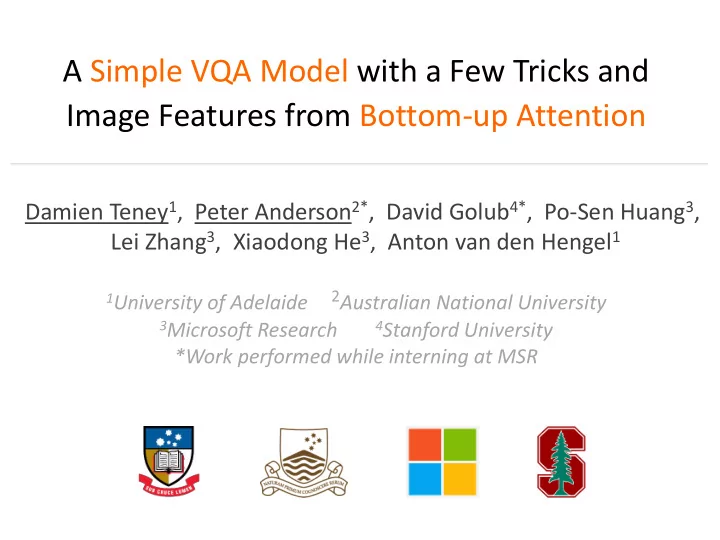

A Simple VQA Model with a Few Tricks and Image Features from Bottom-up Attention Damien Teney 1 , Peter Anderson 2* , David Golub 4* , Po-Sen Huang 3 , Lei Zhang 3 , Xiaodong He 3 , Anton van den Hengel 1 2 Australian National University 1 University of Adelaide 3 Microsoft Research 4 Stanford University *Work performed while interning at MSR
Proposed model Straightforward architecture ▪ Joint embedding of question/image ▪ Single-head, question-guided attention over image ▪ Element-wise product The devil is in the details ▪ Image features from Faster R-CNN ▪ Gated tanh activations ▪ Output as regression of answer scores, soft scores as target ▪ Output classifiers initialized with pretrained representations of answers
Gated layers Non-linear layers: gated hyperbolic tangent activations ▪ Defined as: input x , output y intermediate activation gate combine with element-wise product ▪ Inspired by gating in LSTMs/GRUs ▪ Empirically better than ReLU, tanh, gated ReLU, residual connections, etc. ▪ Special case of highway networks; used before in: [1] Dauphin et al. Language modeling with gated convolutional networks, 2016. [2] Teney et al. Graph-structured representations for visual question answering, 2017.
Question encoding Chosen implementation Better than…. ▪ ▪ Pretrained GloVe embeddings, d=300 Word embeddings learned from scratch ▪ ▪ GRU encoder GloVe of dimension 100, 200 ▪ Bag-of-words (sum/average of embeddings) ▪ GRU backwards ▪ GRU bidirectional ▪ 2-layer GRU
Classical “top - down” attention on image features Chosen implementation Better than…. ▪ ▪ Simple attention on image feature maps No L2 normalization ▪ ▪ One head Multiple heads ▪ ▪ Softmax normalization of weights Sigmoid on weights
Output Chosen implementation Better than…. ▪ ▪ Sigmoid output (regression) of answer scores: Softmax classifier allows multiple answers per question ▪ ▪ Soft targets in [0,1] Binary targets {0,1} allows uncertain answers ▪ ▪ Initialize classifiers with representations of answers Classifiers learned from scratch W of dimensions nAnswers x d
Output Chosen implementation ▪ Sigmoid output (regression) of answer scores: allows multiple answers per question ▪ Soft targets in [0,1] allows uncertain answers ▪ Initialize classifiers with representations of answers Initialize W text with GloVe word embeddings Initialize W img with Google Images (global ResNet features)
Training and implementation ▪ Additional training data from Visual Genome: questions with matching answers and matching images (about 30% of Visual Genome, i.e. ~ 485,000 questions) ▪ Keep all questions, even those with no answer in candidates, and with 0<score<1 ▪ Shuffle training data but keep balanced pairs in same mini-batches ▪ Large mini-batches of 512 QAs; sweet spot in {64, 128, 256, 384, 512, 768, 1024} ▪ 30-Network ensemble: different random seeds, sum predicted scores
Image features from bottom-up attention ▪ Equally applicable to VQA and image captioning ▪ Significant relative improvements: 6 – 8 % (VQA / CIDEr / SPICE) ▪ Intuitive and interpretable (natural approach)
Bottom-up image attention Typically, attention models operate on We calculate attention at the level of the spatial output of a CNN objects and other salient image regions
Can be implemented with Faster R-CNN 1 ▪ Pre-train on 1600 objects and 400 attributes from Visual Genome 2 ▪ Select salient regions based on object detection confidence scores Take the mean-pooled ResNet-101 3 feature from each region ▪ 1 NIPS 2015, 2 http://visualgenome.org, 3 CVPR 2016
Qualitative differences in attention methods Q: Is the person wearing a helmet ? ResNet baseline Up-Down attention Up-Down attention ResNet baseline Q: What foot is in front of the other foot ?
VQA failure cases: counting, reading Q: How many oranges are sitting on pedestals? Q: What is the name of the realtor?
Equally applicable to Image Captioning ResNet baseline: A man sitting on a toilet in a bathroom. Up-Down attention: A man sitting on a couch in a bathroom.
MS COCO Image Captioning Leaderboard ▪ Bottom-up attention adds 6 – 8% improvement on SPICE and CIDEr metrics (see arXiv: Bottom-Up and Top-Down Attention for Image Captioning and VQA) ▪ First place on almost all MS COCO leaderboard metrics
VQA experiments ▪ Current best results Ensemble, trained on tr+va+VG, eval. on test-std Yes/no: 86.52 Number: 48.48 Other: 60.95 Overall: 70.19 ▪ Bottom-up attention adds 6% relative improvement (even though the baseline ResNet has twice as many layers) Single-network, trained on tr+VG, eval. on va
Take-aways and conclusions ▪ Difficult to predict effects of architecture, hyperparameters, … Engineering effort: good intuitions are valuable, then need fast experiments Performance ≈ (# Ideas) * (# GPUs) / (Training time) ▪ Beware of experiments with reduced training data ▪ Non-cumulative gains, performance saturates Fancy tweaks may just add more capacity to network May be redundant with other improvements ▪ Calculating attention at the level of objects and other salient image regions (bottom-up attention) significantly improves performance Replace pretrained CNN features with pretrained bottom-up attention features
Questions ? Tips and Tricks for Visual Question Answering: arXiv:1708.02711: Learnings from the 2017 Challenge Bottom-Up and Top-Down Attention arXiv:1707.07998: for Image Captioning and VQA Damien Teney, Peter Anderson, David Golub, Po-Sen Huang, Lei Zhang, Xiaodong He, Anton van den Hengel
Recommend
More recommend